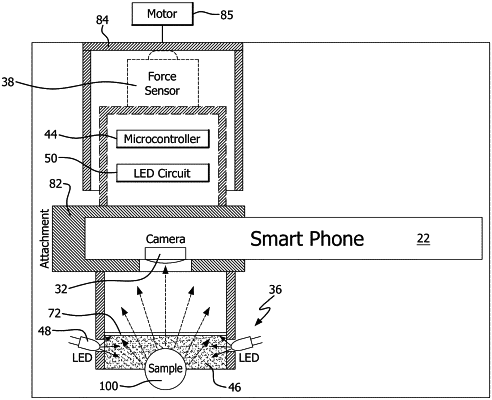| CPC G02B 6/10 (2013.01) [A61B 5/0053 (2013.01); A61B 5/0059 (2013.01); A61B 5/444 (2013.01); A61B 5/6843 (2013.01); A61B 5/6898 (2013.01); A61B 5/7267 (2013.01); A61B 5/7275 (2013.01); G01N 3/08 (2013.01); G01N 19/00 (2013.01); G06T 7/0012 (2013.01); G06V 10/10 (2022.01); G06V 10/147 (2022.01); H04M 1/04 (2013.01); A61B 5/0022 (2013.01); A61B 2090/306 (2016.02); A61B 2562/0238 (2013.01); A61B 2576/00 (2013.01); G06T 2207/30096 (2013.01); H04M 2250/12 (2013.01)] | 20 Claims |

|
20. A method of determining a risk index for an object based on a surface or subsurface size of the object and a softness index of the object using a mobile-platform imaging device that uses compression of a target region to generate an image of the object, the mobile imaging device comprising:
a tactile sensor comprising an optical waveguide comprising at least a first layer that is flexible and transparent, the tactile sensor further comprising at least one light source configured to direct light into the optical waveguide, wherein the optical waveguide is configured so that at least some of the light directed into the optical waveguide is scattered out of the first layer when the first layer is deformed, and wherein the first layer is deformed by the tactile sensor being pressed against the target region;
a force sensor that detects a force being applied to press the tactile sensor against the target region and outputs corresponding force information;
a first communication unit connected to receive the force information from the force sensor and to associate with the force information a force time when the force information was obtained; and
a receptacle for holding a mobile device having a second communication unit and an imager so positioned that the imager can generate image information using at least some of the light scattered out of the first layer;
wherein the first communication unit is configured to communicate with the second communication unit and the mobile device is configured to communicate with an external network; and
wherein the second communication unit is programmed to control activation of the imager and, when the imager is activated to capture an image, to associate an image time with the captured image, and to retrieve from the first communication unit the force information that was received from the force sensor at the force time that the image was captured, the second communication unit further programmed to associate the captured image with the force information at the common force time and image time;
the method comprising the steps of:
activating the imager to capture the image;
associating an image time with the captured image;
retrieving from the first communication unit the force information that was received from the force sensor at the image time;
associating with the force information a force time when the force information was obtained for the captured image, the force time being common with the image time;
associating the captured image with the retrieved force information at the common force time and image time;
estimating the size of the object using 3D interpolation based on the captured image and the associated force information;
determining a contact area of the applied force associated with the image information that is generated for each image by the imager from light scattered out of the first layer due to each applied force,
determining stress for each image from the contact area of the tactile sensor and the force information:
determining a softness index of the object based on a deformation in each image associated with the applied force and the determined stress for each image in accordance with the following equation:
 where σz(k) is the stress calculated in the normal direction for each image (k), and dz(k) is a deformation ratio for each image (k); and
determining a risk index for the object based on the estimated size of the object and the softness index of the object.
|